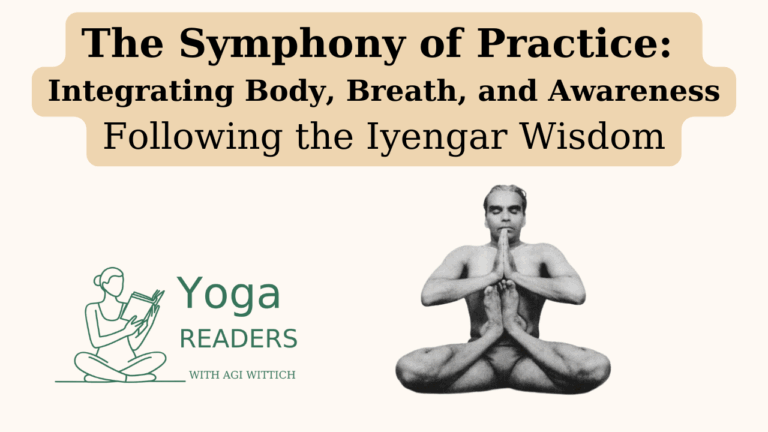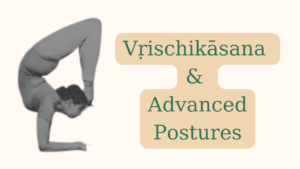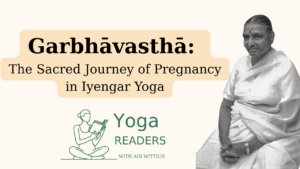
When the World Stops: How Iyengar Yoga Becomes an Anchor in Times of Crisis
I recently had the oppo rtunity to share my experience of teaching yoga during wartime, and the response has been overwhelming. People from around

“The rhythm of the body, the melody of the mind, and the harmony of the soul create the symphony of life.” With these poetic words from Light on Life, B.K.S. Iyengar evokes an image that is not merely metaphorical but a lived, embodied reality for the dedicated sādhaka. In Iyengar Yoga, practice is not a compartmentalized pursuit of āsana, prāṇāyāma, and dhyāna. Rather, it is an orchestrated integration of these elements, tuned through svādhyāya (self-study), honed through abhyāsa (repeated effort), and refined through viveka (discernment). The goal is not performance but harmony: a state in which every kosha, from the annamaya to the anandamaya, vibrates in accord.
The Rhythm of the Body: Converting Movement into Intelligent Action
The rhythm of the body is established through precise, conscious movement. But movement in the Iyengar method is not mere repetition. Guruji often emphasized that “movement becomes action only when infused with intelligence.” In other words, rhythm is not imposed; it is revealed when we align the body correctly, respect anatomical integrity, and observe the fluctuations of energy within the pose. The practitioner learns to balance sthira (steadiness) and sukha (ease), extension and restraint, weight and lightness.
Geeta S. Iyengar, in Yoga: A Gem for Women, offers an exemplary model of how rhythm is cultivated through intelligent sequencing. Each āsana, thoughtfully placed in relation to what precedes and follows it, becomes a note in a greater composition. Twists stimulate digestion and organ vitality; backbends invigorate the adrenal system; inversions reverse habitual patterns and direct the mind inward. This sequencing is not formulaic but responsive. It allows the practitioner to find their own cadence—sometimes brisk and expansive, other times slow and contemplative.
For a broader understanding of how these elements of practice mirror the organic development of the yogic path, I invite you to explore Part 2: The Tree and Its Parts. It unpacks the metaphor of the yogic tree from The Tree of Yoga, offering a powerful framework to understand the interdependence of practice components.
The Melody of the Mind: Cultivating the Sattvic Tone
As the body finds its rhythm, the mind begins to express its own melody. This is not the agitated tune of unchecked thought, but the gradually quieting voice of discriminative awareness. Guruji referred to the incessant chatter of the citta vṛttis as noise, which must be tuned and refined like an instrument. With sustained effort and breath regulation, the mind moves from rajas (restlessness) and tamas (lethargy) toward sattva—clarity, stillness, and inner illumination.
In Light on Life, Guruji reminds us that meditation is not simply the absence of thought but a dynamic state of alert stillness. Like a musician listening deeply between the notes, the yogi becomes attuned to the spaces between breath and the quiet echoes of the mind. In Yoga: A Gem for Women, Geeta writes, “A pure mind is a harmonious mind.” This harmony emerges not by silencing the mind through willpower, but by bringing all aspects of the self into coherent relationship.
The Harmony of the Soul: When Practice Becomes Prayer
The culmination of this integration—rhythmic body, melodic mind—is the harmony of the soul. This is the anandamaya kosha expressing itself not as an abstract ideal but as a lived frequency, an inner resonance that arises when the individual self (jīva) aligns with its source (puruṇa). This is not merely a philosophical idea; it is an experience touched in the deepest moments of prāṇāyāma, in the poised silence after savāsana, or in the quiet gaze that emerges after an intense practice.
Patañjali defines yoga as “yogaṣ citta-vṛtti-nirodhaḥ”—the cessation of the fluctuations of the mind. But Guruji elaborates: this cessation is not empty. It is “alert, positive, and supremely aware.” In this state, the whole being vibrates in a single frequency. We no longer perform practice. We become practice.
Geeta S. Iyengar’s work shows us how this harmony takes different expressions across the phases of a woman’s life. Her therapeutic sequences for menstruation, menopause, and pregnancy demonstrate that the symphony of practice must be adapted without compromising its integrity. Even when the tempo changes, the inner coherence remains. Whether we move through standing poses or restorative forms, we maintain connection with the breath, precision in form, and attention in consciousness.
Conducting Your Practice: From Technique to Sensitivity
A beautiful symphony requires a skilled conductor. In yoga, the practitioner must become both the instrument and the conductor. Technical clarity—rekha (alignment), the intelligent use of props, and the sequencing of āsanas and prāṇāyāma—is indispensable. But this alone is not enough. Sensitivity is essential. The yoga practitioner must read the instrument of their own body-mind daily and respond appropriately. This is the movement from technique (yukti) to wisdom (pratibhā).
Some days, the music of practice may be vigorous—a rāga in a major key. On other days, it may be slow, internal, and spacious—like a meditative alap. The mature practitioner does not impose a mood or tempo but listens for what is needed and responds with care. As B.K.S. Iyengar reminds us in Tree of Yoga, “Yoga is the method by which we can learn to conduct the orchestra of the different elements of our being.”
An Invitation to Practice: Your Inner Composition
Today, approach your practice as you would a musical composition. Begin not with a goal but with a listening ear. Let your body establish its rhythm. Let the breath reveal the inner melody. Let your attention guide the harmony. Don’t rush to finish. Stay in the process. Let each posture, each breath, each pause be part of the composition.
Yoga is not a solo performance. It is a dialogue between body and mind, breath and space, effort and grace. It is a dynamic interplay in which you are both listener and performer, observer and participant.
Where is the dissonance in your system today, and how can you tune it with care? What tempo does your body ask for? What key is your mind in? Can you adjust the rhythm until the whole system—body, breath, and awareness—resonates as one?
When that happens, yoga ceases to be something you do. It becomes something you are.
If you’d like to support my work, you can Buy Me a Chai – and help keep these teachings flowing freely.

I recently had the oppo rtunity to share my experience of teaching yoga during wartime, and the response has been overwhelming. People from around

In the realm of yoga practice, advanced āsanas often spark both fascination and fear. Yet, as Geeta Iyengar explains in “Yoga: A Gem for

The moment you discover you’re carrying new life, everything changes. Your body becomes a vessel of creation, your breath sustains two beings, and every
Agi Wittich is a yoga practitioner since two decades, and is a certified Iyengar Yoga teacher. Wittich studied Sanskrit and Tamil at the Hebrew University of Jerusalem, Israel, completing a PhD with a focus on Hinduism, Yoga, and Gender. She has published academic papers exploring topics such as Iyengar yoga and women, the effects of Western media on the image of yoga, and an analysis of the Thirumanthiram yoga text.